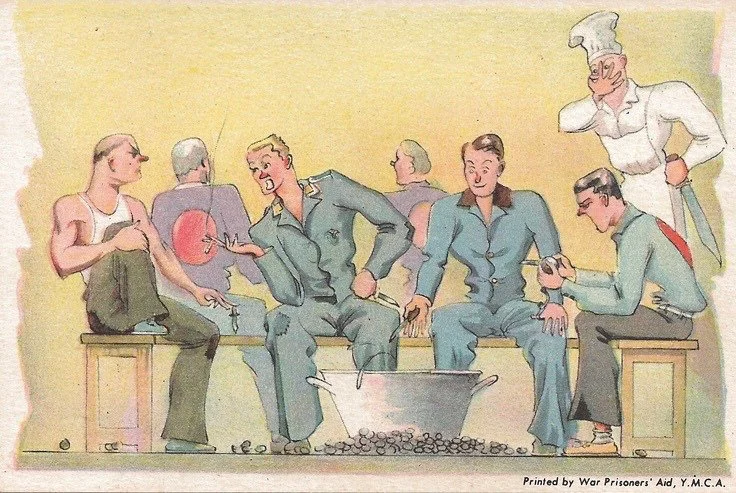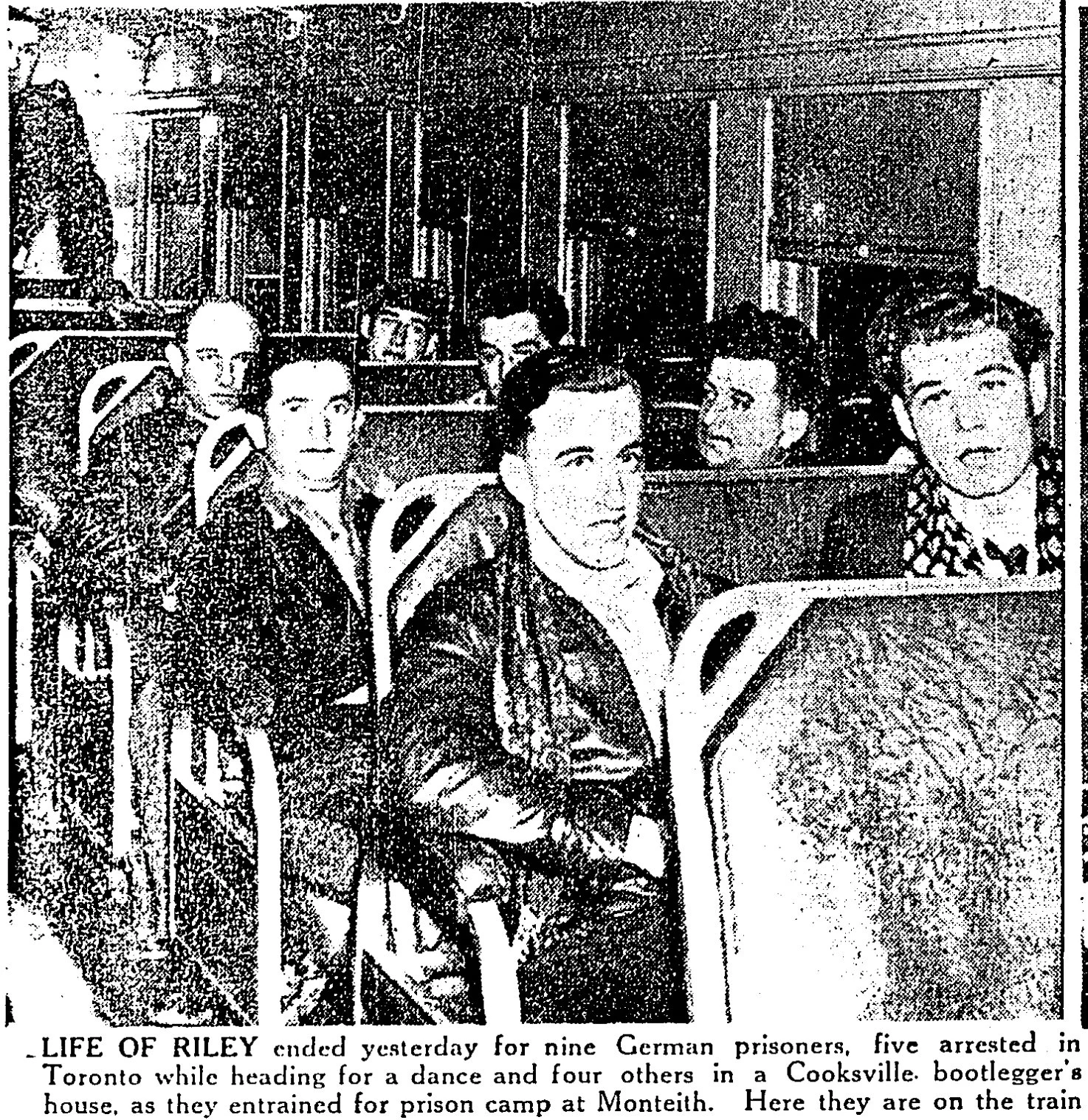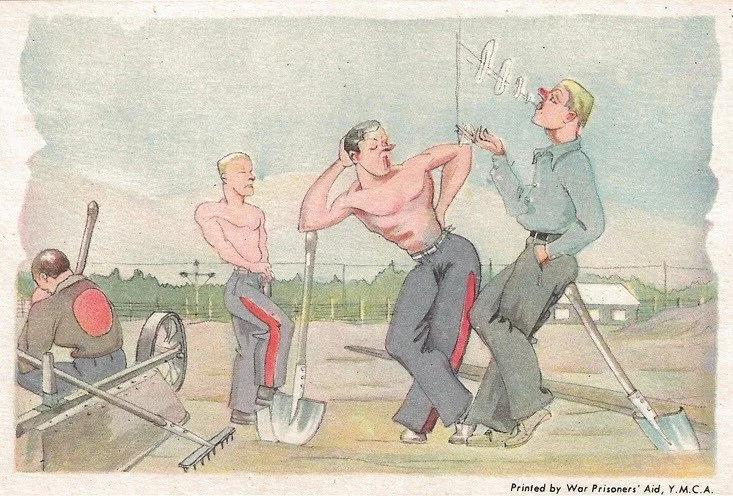Prisoners of War at the Cooksville Brickyard in Mississauga: Silk Scarves, Dances, & Bootleggers
/We invite you to visit Heritage Mississauga’s office at The Grange (1921 Dundas Street West) to view the exhibit and marvel at our collection of ships in bottles, unique works of art created by the German Merchant Marine POWs at the Cooksville brickyard, and to help us explore and document the stories connected to them. We know of some of these stories thanks to the research undertaken by Zoe Arruda through the University of Toronto Mississauga Historical Studies Internship Program. The exhibit will be on display until September. This article is a continuation of the ongoing series focusing on the lives of some of the POWs while they were in Canada.
“Peeling” - Courtesy of Michael OHagan - POW Mail and the YMCA
From 1944 until 1946, more than 200 Prisoners of War (POWs) worked at the Cooksville Brickyard in Mississauga, employed through a program led by the Department of Labour of Canada to reduce the country’s labour shortage. Much to the dismay of the Department of Defence, the security at the Cooksville Brickyard was relaxed, affording the POWs opportunities to travel across the Greater Toronto Area and beyond, spanning all the way from Niagara Falls to Toronto. The POWs were technically not allowed to leave the Brickyard; so how did they get so far?
The answer is stubbornly human: community. Despite legal restrictions, people connected with the POWs and built all kinds of relationships with them. They were co-workers, friends, and sometimes even lovers. People were curious about the POWs, and the POWs were curious about Canada.
March 9 1946 Toronto Daily Star
Cooksville gained a reputation for being too friendly with their POWs. While many continued to leave the Brickyard premises without consequence, one eventful night led to the beginning of the end for the labour project: March 7th, 1946.
After the evening headcount, several POWs left their beds in favour of something exciting. Just down the road, a car waited for them, just as it had been every night for the past few weeks. In the driver’s seat is Isaac Kathnelson, a Canadian Brickyard worker who charged the POWs a one-dollar fare (about $17.50 in today’s money) to take them anywhere they wanted to go and pick them up at the end of the night. Five POWs dressed in expensive clothes pile into his car: Heinz Volmer, Nicolaus Freund, Herbert Hildner, Oscar Timm, and Albert Maceijewski. They were headed towards Toronto to attend a dance at the Palais Royale.
On account of their civilian clothing, the POWs were not different to Canadian citizens by appearance alone. POWs were required to wear uniforms that identified them as such, consisting of a denim jumpsuit with red stripes up the legs and a large red circle on the back. Of course, since the POWs at Cooksville were active in the community, they also bought, traded, and were gifted regular civilian clothing.
“Smoking” - Courtesy of Michael OHagan - POW Mail and the YMCA
These “disguises” did not fool everyone, however. While out driving, Stanley Harper, a former Brickyard worker, recognized the POWs. Harper was a veteran who had been torpedoed by Germans in the North Atlantic and after being discharged, worked at the Cooksville Brickyard but later quit due to the lax attitudes towards the POW workers. He notified the police about the escaped POWs, resulting in their capture. Taking note of the POW’s silk scarves and fancy watches, the police searched homes in Cooksville in hopes of finding discarded POW uniforms as evidence.
Instead, they found four other POWs in the homes of other Brickyard worker’s families: August Ehrhard, Otto Hipp, Ernst Bauke, & Ewald Prenzal.
Ehrhard was found in the home of Angelo Fedrigo, discovered in a “compromising position” in bed with a woman who identified herself as Anna Block (though, this is believed to possibly have been a fake name). The other three POWs were discovered highly intoxicated and drinking beer in the residence of Guglielmo Basso. They had been visiting from the early evening, even having left the Basso residence to attend the routine headcount before returning to continue drinking together.
March 9 1946 Toronto Daily Star
Fedrigo and Basso were apprehended for harbouring the POWs and running a “bootlegging establishment,” and were fined $250 each (today, about $4,370 each) for the incident. They were lucky to avoid jail time. The Magistrate was less kind to Kathnelson, who was sentenced to three months of jail after admitting he had been transporting POWs to theatres, restaurants, and dances over the previous seven weeks.
The fate of all the POWs who got caught this night was the same: they were to return to Camp 23, no longer allowed to work in any of the Department of Labour’s projects. The clear evidence of the relationships the POWs had with the community was the final straw after years of similar incidents, and the Department of Defence called for the termination of POW labour at the Cooksville Brickyard altogether. By 1947, there were no remaining POW workers at the Brickyard.














